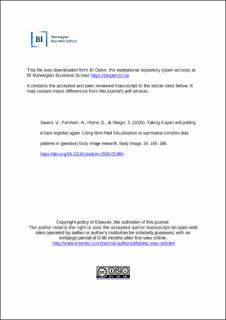| dc.contributor.author | Swami, Viren | |
| dc.contributor.author | Furnham, Adrian | |
| dc.contributor.author | Horne, George | |
| dc.contributor.author | Stieger, Stefan | |
| dc.date.accessioned | 2021-09-29T11:00:44Z | |
| dc.date.available | 2021-09-29T11:00:44Z | |
| dc.date.created | 2020-07-14T14:29:00Z | |
| dc.date.issued | 2020 | |
| dc.identifier.citation | Body image. 2020, 34 155-166. | en_US |
| dc.identifier.issn | 1740-1445 | |
| dc.identifier.uri | https://hdl.handle.net/11250/2785990 | |
| dc.description.abstract | Issues of construct commonality and distinguishability in body image research are typically addressed using structural equal models, but such methods can sometimes present problems of interpretation when data patterns are complex. One recent-developed tool that could help in summarising complex data patterns is Item Pool Visualisation (IPV), an illustrative method that locates item pools from within the same dataset and illustrates these in the form of single or nested radar charts. Here, we demonstrate the utility of IPV in visualising data patterns vis-à-vis positive body image. Five-hundred-and-one adults from the United Kingdom completed seven widely-used measures of positive body image and data were subjected IPV. Results demonstrated that, of the included measures, the Body Appreciation Scale-2 provided the closest and most precise measurement of a core positive body image construct. The Functionality Appreciation Scale and the Authentic Pride subscale of the Body and Appearance Self-Conscious Emotions Scale tapped more distal aspects. Our results also highlight possible limitations with the use of several other instruments as measures of positive body image. We discuss implications for research aimed at better understanding the nature of positive body image and interpreting complex data patterns in body image research more generally. | en_US |
| dc.language.iso | eng | en_US |
| dc.publisher | Elsevier | en_US |
| dc.rights | Attribution-NonCommercial-NoDerivatives 4.0 Internasjonal | * |
| dc.rights.uri | http://creativecommons.org/licenses/by-nc-nd/4.0/deed.no | * |
| dc.subject | Positive body image | en_US |
| dc.title | Taking it apart and putting it back together again: Using Item PoolVisualisation to summarise complex data patterns in (positive) bodyimage research | en_US |
| dc.type | Journal article | en_US |
| dc.type | Peer reviewed | en_US |
| dc.description.version | acceptedVersion | en_US |
| dc.source.pagenumber | 155-166 | en_US |
| dc.source.volume | 34 | en_US |
| dc.source.journal | Body image | en_US |
| dc.identifier.doi | 10.1016/j.bodyim.2020.05.004 | |
| dc.identifier.cristin | 1819398 | |
| cristin.ispublished | true | |
| cristin.fulltext | postprint | |
| cristin.qualitycode | 1 | |

